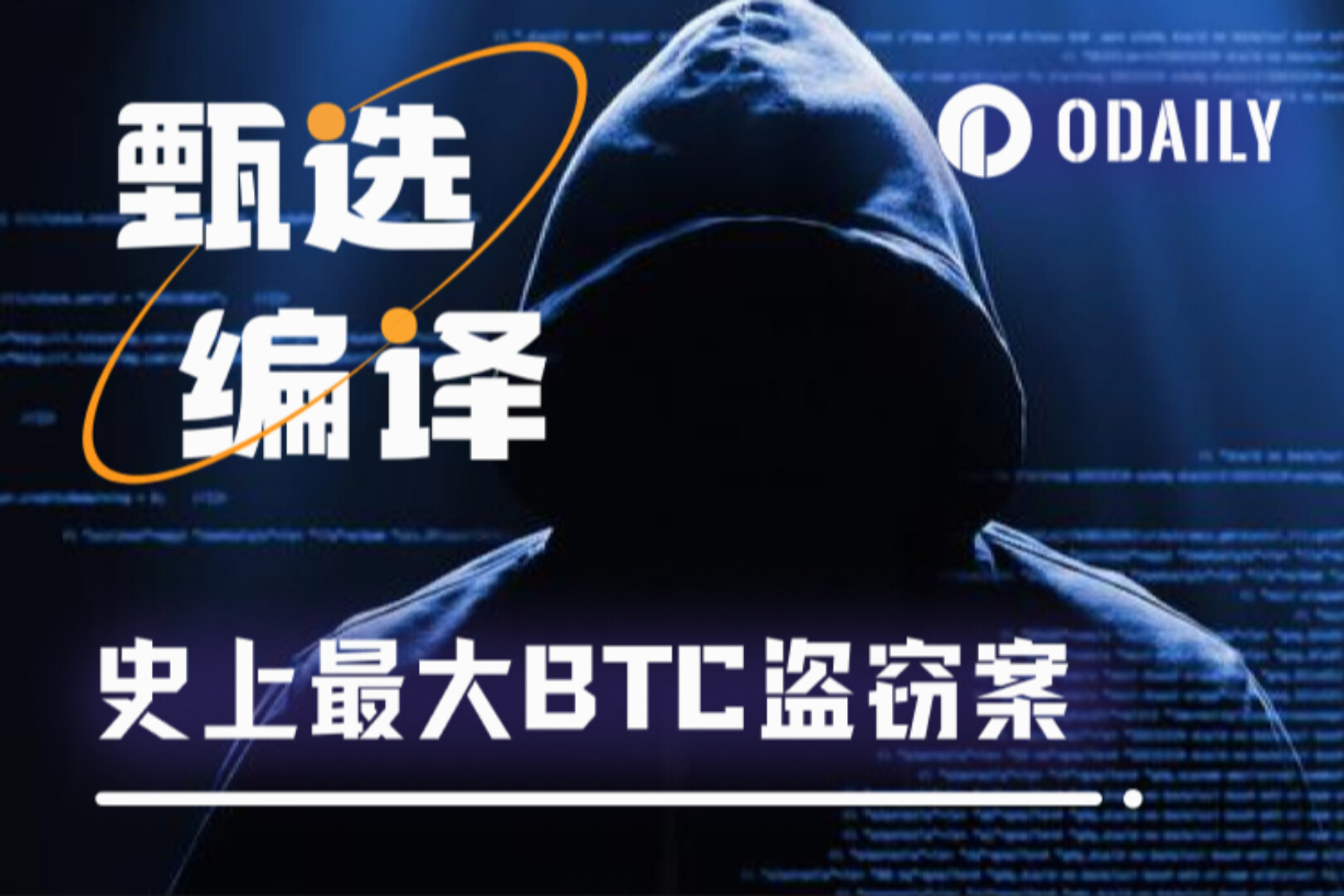Original Title: Portfolio Insights: Aptos
Authors: Allen Zhao, Mustafa Yilham, Henry Ang & Jermaine Wong
Foreword:
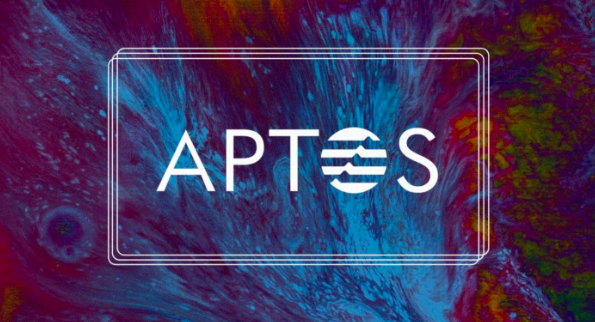
Foreword:
Bixin Ventures is pleased to announce its strategic investment in Aptos, a high-performance public chain based on Move. This round of financing is a continuation of the Aptos team’s announcement in late July this yearnew round of financingTable of contents:
Table of contents:
1. Performance
2. Security
3. Development Roadmap
4. Aptos Funding Program
5. Ecological Status
6. Conclusion & Thinking
first level title
A blockchain focused on security and scalability
Aptos is a new L1 blockchain with the vision of helping billions of people create assets and access the network in a fair, decentralized, and permissionless manner. Aptos is also known as Diem's "son". Solana co-founder Anatoly even believes that Aptos is Solana's direct competitor compared to other EVM blockchains. Aptos by CEOMo Shaikhand CTOAvery Chingco-founded. CTO Avery Ching was once the technical director of the most famous Diem blockchain inside Meta. Prior to Meta, Mo worked at Consensys, BlackRock and Boston Consulting Group, while Avery worked at Yahoo. Aptos Team'sother membersComposed of PhDs, researchers, engineers, designers, and strategists who have worked for Meta, Novi, Amazon, VMware, and more.
first level title
1. Performance
secondary title
1. Batched Transactions through Proof of Availability
image description
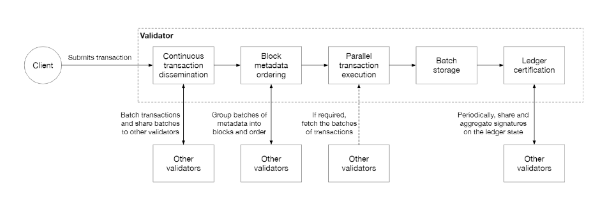
transaction lifecycle
Transactions are transferred between validators in batches. Afterwards, validators will sign each batch digest, forming a Proof of Availability (PoAv) when more than ⅔ validator signatures are collected. PoAv ensures that transaction batches will be stored locally by at least ⅓ honest validators, who can then retrieve transaction batches prior to execution. Therefore, the transaction process can only use the batch metadata and proofs required in each block for ordering, thereby improving transaction TPS and minimizing the time to determine the block.
here
clickheresecondary title
2. Parallel execution engine: Block-STM
Block-STM is an efficient, multi-threaded parallel execution engine, theoretically up to 160k TPS. Compared with other parallel execution techniques, Block-STM pre-declares all dependencies, avoiding restrictions on transactions or forcing them to be broken down into small parts, Block-STM can detect access violations within the preset transaction order, thereby extracting the most transaction processing.
The following are the key features of Block - STM:
Optimistic Concurrency Control: The transaction will be executed in an Optimistic manner, and verification will be completed after execution. If validation is unsuccessful, the transaction will be re-executed, and all associated transactions will need to be re-validated before they can be committed.
Multi-version data structure: all writes to the same location are stored with their associated versions to avoid conflicts of simultaneous writes every time there is a new transaction
Validation: During execution, transactions are split into read and write sets. During validation, all memory locations in the read set compare the returned versions with the corresponding versions in the write set.
Cooperative Scheduler: Coordinates validation and execution tasks among threads through a count-based approach.
Dynamic dependency estimation (Dynamic dependency Estimation): All failed validations will result in an "ESTIMATION" value being recorded in the multiversion data structure of the associated writeset. This will ensure that all future transactions will wait for any dependencies to be resolved before proceeding.
Overall, Block-STM uses a cooperative scheduler and multi-version data structures to estimate pre-set transaction order dependencies and reduce aborts. Block-STM then uses a series of atomic counters to ensure that the entire block can be committed.
hereheresecondary title
3. State synchronization
State synchronization is key to Aptos architecture design, the following are their key features:
Short completion time: through the rapid dissemination of data between nodes, thereby reducing the time of transaction processing
Up-to-date consensus: by bringing a crash or a new validator to the latest blockchain state
Data correctness: preventing malicious actors from modifying or censoring data in the network;
More decentralized: By increasing the frequency of rotating the active validator set and allowing more nodes to come online in less time.
Upgradability: Validator management and configuration is done via on-chain state for fast and upgradable
In order to build this state synchronization protocol, Aptos must ensure that it:
Persistent storage: Protect against machine failures and enable data distribution with RocksDB
Verifiable blockchain: Merkle roots and resulting states of submitted transactions verified by validators
Trust basis to prevent malicious modification of blockchain data;
This allows validators to sync to the blockchain at any time via the genesis block (first validator set + initial blockchain state) and trusted pathpoints (current validator set hash + blockchain state). And Aptos can perform state synchronization with other nodes (such as full nodes or other verification nodes) at a rate of more than 10k TPS, with sub-second block certainty and moderate hardware requirements.
Data prefetching: reduce the time for the network to determine a block by prefetching transaction data (transaction + state increment) before processing
Pipeline Execution and Storage: Increase synchronous TPS by separating transaction execution and storage persistence.
Peer Monitoring: Optimize peer selection when requesting new blockchain data through peer monitoring of behavior, distance to validator set, and local scoring.
Data caching: reduces the read load on storage by storing commonly requested data items and responses in memory
Storage Cleanup: Prevents storage from bloating over time by removing unnecessary transactions and blockchain data from storage.
In order to achieve 100K+ TPS to match Block-STM, the Aptos team has determined the next optimizations:
Batch transactions: reduce expensive verification and storage by verifying proofs of batches of transactions versus individual transactions
Network Compression: Optimize bandwidth for scalability by compressing transmitted data and serialized data distribution
Faster Storage Writes: Reduce the time to write blockchain data to storage by using more efficient data structures and storage configurations or alternate storage engines
here
clickherefirst level title
secondary title
1. Smart contract programming language - Move
Move was originally developed by Facebook for writing secure smart contracts. It is platform-agnostic, enabling shared libraries, tools, and developer communities across blockchains. The Move language is designed with an emphasis on security to avoid many scenarios where Web 3.0 users are victimized, including but not limited to re-entrancy vulnerabilities, poison tokens, and spoofed tokens approvals) and other issues.
For additional protection, Move can be used withMove ProverDevelopment is aided by a verification tool that allows developers to write formal specifications for key characteristics of their applications and use a verifier to check the code for correct execution within 30 seconds.
Move's biggest strength is its asset data model, which allows for a high degree of composability. Move assets are arbitrary user-defined types, which means assets can be passed as parameters, stored in other assets, and more importantly, assets can be moved freely across contract boundaries without losing their integrity. This is in stark contrast to EVM-style assets written in Solidity, which are forever trapped in the contract that defines it.
Aptos through the adapter layerexpandAdditional features of the core MoveVM, including parallel execution via Block-STM, allow transactions to be executed concurrently without any input from the user.
here
clickheresecondary title
2. Consensus mechanism: AptosBFT
Aptos' consensus mechanism is derived from the HotStuff protocol originally designed for Diem, on which the team has worked on its 4th iteration. The following are the key mechanisms of AptosBFT:
1) Byzantine fault tolerance
The network cannot be compromised until more than ⅓ malicious validators agree
Once confirmed by >⅔ of validators, the transaction is guaranteed to be completed
2) Separation of activity and security of the protocol
As long as Aptos' BFT consensus exists, the network will not fork
Prevent DDoS attacks on the network
3) Reputation-based leadership system
Track active validators with last committed state
Analyze on-chain state and automatically rotate leader nodes to accommodate unresponsive validator situations
here
clickhereto learn more about AptosBFT.
In addition, the Aptos team is testing its next-generation protocol on the work products of other research groups — includingNarwhal & Tusk、Bullsharksecondary title
3. Key recovery and rotation protocol
secondary title
4. Open and transparent transaction pre-signature
first level title
secondary title
testnet
Aptos has developed their testnet roadmap in preparation for a robust mainnet launch. The table below covers key objectives and important timelines:
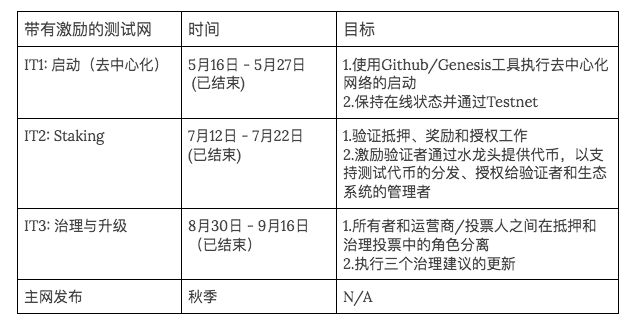
The testnet provided a lot of valuable content, giving us further confidence that the mainnet launch will be robust. Here are some of the questions and responses the team has learned from past testing:
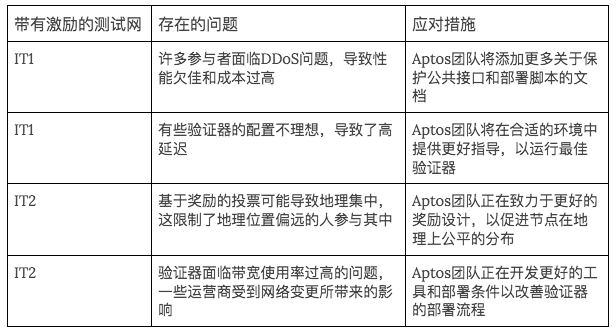
learnandandIT2 (details)summary of
At the time of writing, snapshots of participant performance in AIT3 have been recorded, with nodes free to leave the setup. AIT3 has been converted to a long-running testnet, providing a stable environment for developers. The developers set up a long-running test network to demonstrate their confidence in the long-term stable operation of the software stack, paving the way for the successful launch of the main network later.
first level title
4. Aptos Funding Program
The Aptos grant program was announced at the end of June and provides funds to accelerate the development of the dApp ecosystem. Subdivided tracks of funded products include:
Developer Tools, SDKs, Libraries, Documentation, Guides, Tutorials
Tools and frameworks for systems development, governance, DeFi and NFTs
Core protocol contributions: token standards, libraries, protocol upgrades, etc.
Open Source and Public Goods
here
clickherefirst level title
5. Ecological Status
Since Aptos is a non-EVM chain, there may be questions about how it channels liquidity within the ecosystem. With the help of partners and investors, the full-chain interoperability protocol Layerzero will be integrated into the Aptos mainnet after its release, allowing users to enter the Aptos ecosystem through Layerzero and provide liquidity for Aptos. Currently, the blockchains supported by Layerzero include Ethereum, Optimism, Arbitrum, Binance Smart Chian, Avalanche, etc.
In terms of projects, there are more than 2,100 forks and 3,800 stars in the Aptos core repository, and now there are more than200A project across DeFi, NFT, games and other fields hopes to be deployed on the mainnet around the end of September.
Here are some interesting projects:
Pontem is one of the early projects in the Aptos ecosystem, including a wallet and a live AMM. As part of their roadmap, they intend to build a Move VM (for cross-chain deployment) and a Move VM-compatible EVM (for interoperability with other blockchains).
Martian Wallet is a crypto wallet that helps users manage digital assets and access dApps on the Aptos blockchain. they can be used in the futureChrome extensionand iOS applications. As of the end of August, it had been downloaded more than 100,000 times.
Switchboard is a permissionless, customizable multi-chain oracle protocol for general data feeding and verifiable randomness. They live on Solana and recently announced their devnet on Aptos. Switchboard has already integrated some notable projects such as Tusnami Finance, Houston Swap, and Econia Labs.
Econia is a highly parallel DEX running on DecNet. It adopts the on-chain order book mode for transaction matching. Since it agrees to adopt Aptos' parallel execution engine Block-STM, it has significant advantages in transaction speed and efficiency.
Topaz, which is currently in closed beta, is the first NFT market on the Aptos network, providing a platform for NFT creators and artists to create.
Ditto Finance is a secure decentralized liquidity staking platform from Aptos. There is currently a lack of native delegation on Aptos, which provides staking yield for users who cannot run validators.
first level title
6. Conclusion & Thinking
Aptos focuses on building fast, secure, scalable and upgradeable L1 blockchains. Although the security benefits of the Move programming language are well documented, the developer ecosystem is still in its infancy, which may affect the development of the dApp ecosystem on Aptos. On a broader level, the L1 space is highly competitive, and with many high-performance L2s emerging, there is intense competition to attract developers, which will impact ecosystem building and subsequent market adoption.
However, the results of the Aptos Devnet launched in March are encouraging, with more than 200 projects involving DeFi, NFT, games and other fields requesting to be deployed on the mainnet. Additionally, the Aptos grant program launched in June will further incentivize developer growth and accelerate dApp development.
Overall, we think the team is capable of realizing their vision. The recently launched incentivized testnet also proves that the team is very proactive in solving problems. We will also continue to pay attention to information such as the economic model of the project.
first level title
image description

Please Note: The above image is the requirements at the time of writing, these requirements may change over time
Aptos full nodes do not participate in consensus. Instead, these nodes re-execute all transactions in the history of the Aptos blockchain and store the results locally, which they will use to challenge and provide evidence when any violations by validators are detected.
Validator nodes run the distributed consensus protocol while executing transactions and storing the results locally. They can decide which transactions to include and in what order to execute them. The BFT consensus protocol is then used to validate nodes to agree on the ledger and execution results of the final transaction. This is then propagated to full nodes, which can then carry out their validation process.



